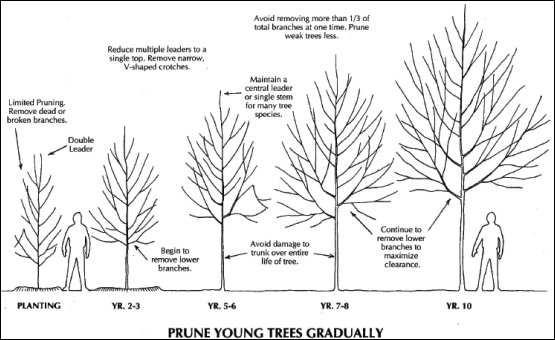Green Horizons
Volume 19, Number 2Spring 2015
Pruning Young Shade Trees
By EUGENE L. BRUNK
As the twig is bent, so grows the tree. This admonition, originally aimed at getting students started in the right direction with regard to their education, also serves as the cardinal principle for pruning trees. How you prune your tree during its first few years, will affect its shape, strength, and life span. In addition, proper pruning will save you money and give you safer, healthier, more beautiful, and easier to maintain trees.
 |
| This illustration provided by the Missouri Department of Conservation depicts the general time frame for pruning young landscape trees. |
Most people tend to keep a closer eye on a newly planted tree than on one that is well established. Sometimes this is a good thing, because one can readily address any problems that might arise, which endanger the young tree. However, a person must also be careful to avoid trying to do too much to "help the tree along," which might also endanger it. In general, it is best to step back and let the newly planted tree establish itself and grow as much as possible during the first year. Of course, it does need the basic protection from mowers, weed whips, insect and disease attacks, etc. There is plenty of time to "bend the twig" after the first year.
In general, you should leave as many branches as possible on a newly planted tree during the first growing season. Remove them only if they are broken. During all stages of the trees life, pruning should be done as lightly as possible, and only when there is good reason to prune. Never remove more than one-third of a trees crown in a season. Remember, it is the leaves which generate the nutrients necessary for good growth (through the photosynthetic process); so the less leaf surface there is, the less food-generating ability the tree has, and that equals less growth and development.
Keys to proper pruning are:
- Prune early in the life of a tree, but don't start until the third year or so, unless there are broken limbs or twigs that need removal immediately.
- Identify the best leader and lateral branches before you begin pruning, and remove any defective parts before pruning to form.
- Keep pruning tools sharp. A clean cut assures faster healing of the pruning wound.
Prune with an eye to the future:
- Remember that a branch does not move up the trunk as a tree grows. A branch 5 feet off the ground now will still be 5 feet off the ground ten years from now - only thicker and longer than it is now.
- Try to visualize the future shape that is desired and prune limbs that won't fit that shape.
- Remove branches that will cause an obvious problem in the future (e.g., a double leader).
- Prune as lightly as possible, and only when there is good reason to prune.
- Never remove more than one-third of a trees crown in one season.